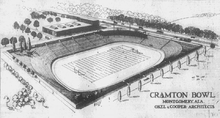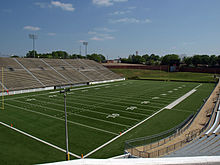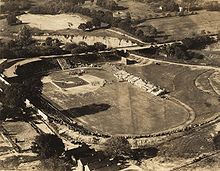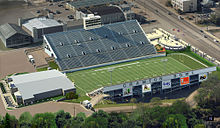- Cramton Bowl
-
Cramton Bowl Location 1022 Madison Avenue,
Montgomery, AL 36107Coordinates 32°22′46″N 86°17′35″W / 32.37949°N 86.293002°WCoordinates: 32°22′46″N 86°17′35″W / 32.37949°N 86.293002°W Opened 1923 Owner City of Montgomery Surface FieldTurf Capacity 24,000 Tenants Alabama State Hornets (NCAA) (?-present)
Faulkner Eagles (NAIA) (2007-present)
Alabama Crimson Tide (NCAA) (1922-1954)
Chattanooga Lookouts (Southern League) (1943)
Montgomery Rebels (Southeastern League) (1938-1949)
Montgomery Bombers (Southeastern League) (1937)
Montgomery Lions (Southeastern League) (1927-1930)Cramton Bowl is a 24,000 seat stadium located in Montgomery, Alabama. Cramton Bowl opened in 1922 as a baseball stadium and has been home to Major League Baseball Spring Training, as well as Minor League Baseball. It is the home stadium for Alabama State Hornets football, the Faulkner University Eagles as well as the areas four high schools. It hosted the first night football game in the South and was once home to the Blue-Gray Football Classic.[1]
Contents
Stadium History
Cramton Bowl is named for F.J. Cramton, who donated the land on which the stadium is built.[2]The location, which is now Cramton Bowl, was originally a sanitary landfill owned by Fred Cramton, a local businessman. After a conversation with friends about the need for a baseball stadium, Cramton donated the land to the City so a facility could be constructed there. The City held the land for a time and then returned it, stating that Cramton’s stadium idea was too big of a project for the City to undertake. Cramton then decided to take matters into his own hands; with the help of the Junior Chamber of Commerce, Cramton raised $33,000 to build the now iconic sports venue.[3]
Capacity
Seating capacity was expanded in 1929 to 7,991. More additions were made in 1946 surging the seating capacity to 12,000.[4] East stands were added in 1962 making the seating capacity 24,000. After new renovations are completed in July 2011 the capacity is expected to be reduced to 21,000.[5]
Baseball
The first baseball game played on the new field was in May of 1922 between Auburn University and Vanderbilt University. Shortly after its completion in 1922 the Philadelphia Athletics decided to move their spring training operations from Eagle Pass, Texas to Montgomery, Alabama. They used the facility for their 1923-1924 spring training and exhibition games before moving to a newer stadium in Fort Myers, Florida. After the departure of the Philadelphia Athletics spring training, Minor league baseball's newly formed Southeastern League placed a team in Montgomery. They became known as the Montgomery Lions. The Lions played in Cramton Bowl from 1927-1930. There was no team from 1931-1936 due to problems within the Southeastern League. The team returned for the 1937 season as the Montgomery Bombers and garnered their first major league baseball affiliation with the Cleveland Indians. The Indians pulled out for the 1938 season and were replaced by the Philadelphia Phillies. After one season the Phillies dropped their affiliation, the team became a co-op franchise and were renamed the Montgomery Rebels. In 1943, the Rebels would disband due to World War II. On July 11th of that year, the Chattanooga Lookouts moved their Washington Senators farm club from Chattanooga's Engel Stadium to Cramton Bowl to play the out the rest of the season. The Rebels returned in 1946 through 1949 before moving to the newly constructed Paterson Field located just across the street.[4][6]
Football
On September 23, 1927, Cramton Bowl became the site of the very first game played “under the lights” in the South with Cloverdale taking on Pike Road High School. Former superintendent D. H. “Sarge” Caraker remembers fondly, “[We] used dishpans for reflectors and sent to California for the lamps. We drew 7,200 people from all over the South to see it.”[3]
College Football
Cramton Bowl plays host to all home games for Alabama State Hornets football as well as those for the Faulkner University Eagles. It is also home to the Turkey Day Classic and in 2009 hosted the inaugural HBCU All-star Bowl.
Cramton Bowl also provided a location for Alabama Crimson Tide football home games in the capital city. The Crimson Tide would play home games at Cramton Bowl in the 1922 through 1932 seasons, in 1934, from 1944 through 1946 and again from 1951 through 1954. Alabama's all-time record at Cramton Bowl was 17 wins and 3 losses.[7]
Cramton Bowl probably achieved its greatest fame as the home of the Blue-Gray Football Classic, an annual college football all-star game which was held there each December from 1938 until 2001.High School Football
Several area high schools call Cramton Bowl home including the Jeff Davis Volunteers, Lanier Poets, Lee Generals, and Carver Wolverines. In July 2011, Cramton Bowl will host the AHSAA Alabama All-Stars Sports Week football game.
Recent History
Cramton Bowl is widely regarded as being functionally obsolete for major sporting events. It is not the capacity of Cramton Bowl that makes it obsolete as much as its age and condition. The age and condition of Cramton Bowl were factors, although not the predominant ones, in the Blue-Gray Game not being held in 2002 and its subsequent relocation in 2003 to Troy, Alabama's Movie Gallery Stadium, about 50 miles (80 km) from Montgomery. Although it is the intent of the Montgomery Lions Club to continue to stage the game (it was not held in 2004 due to the inability to arrange for a corporate sponsor and the consequent naming rights) and it is generally assumed that they would like it to return it to Montgomery if the Cramton Bowl were to be significantly upgraded or totally replaced, as Montgomery's minor league baseball park has been.
2011 Renovations
In mid-2010 the City of Montgomery approved a measure for a $10 million renovation and addition to Cramton Bowl. The renovations planned for Cramton Bowl will be a unique mix of the old and the new. The current structure will stay, but will be revamped and updated with four entrances, a state-of-the-art press box, an aesthetically enhanced plaza area, and a “Walk of Fame”, which will celebrate Montgomery’s sports history and house various articles of historic sports memorabilia. Perhaps the most important and impressive addition will be the 90,000-square-foot (8,400 m2) multi-purpose sports facility.[3] Demolition of the north endzone and press box began in late November 2010, which is phase one of the project. Phase two began in early January 2011 as crews removed an existing brick wall from the south endzone and dismantled the scoreboard to make way for the new multi-purpose sports facility. Work on the stadium is expected to be completed in July 2011 while the new multi-purpose facility is expected to be finished in mid-2012.[8] [9]
Notes and references
- ^ City of Montgomery, website [1]
- ^ "City Dads Accept Cramton Bowl Gift", Montgomery Advertiser, February 9, 1921.
- ^ a b c Fields, Tommy. "The Cramton Conversion". http://mymaxmore.com/index.php?option=com_content&view=article&id=120:the-cramton-conversion&catid=1:current&Itemid=32. Retrieved 2011-05-10.
- ^ a b Baseball-Reference[2]
- ^ Central Alabama Sports Commission[3]
- ^ Digital Ballparks[4]
- ^ University of Alabama Sports Information. "All-time Football Results". http://www.rolltide.com/sports/m-footbl/archive/m-footbl-results-archive.html. Retrieved 2009-01-02.
- ^ Gayle, Tim. "Cramton Bowl to get a face lift: Stadium to be joined by an indoor arena". http://www.montgomeryadvertiser.com/article/20101128/SPORTS0403/11280347/1002/rss03. Retrieved 2010-11-28.
- ^ Gayle, Tim. "Cramton Bowl renovation work reveals hidden rooms". http://www.montgomeryadvertiser.com/article/20110127/SPORTS/101270341/1002/rss03. Retrieved 2011-01-27.
External links
Football stadiums of the Southwestern Athletic Conference East Division Louis Crews Stadium (Alabama A&M) • Cramton Bowl (Alabama State) • Jack Spinks Stadium (Alcorn State) • Mississippi Veterans Memorial Stadium (Jackson State) • Rice–Totten Field (Mississippi Valley State)
West Division Golden Lion Stadium (Arkansas–Pine Bluff) • Eddie Robinson Stadium (Grambling State) • Edward L. Blackshear Field (Prairie View A&M) • Ace W. Mumford Stadium (Southern) • Delmar Stadium / Reliant Stadium (Texas Southern)
SWAC Championship Game College football venues in Alabama Division I
FBSConference USA SEC Bryant–Denny Stadium (Alabama) • Jordan–Hare Stadium (Auburn)
Sun Belt Division I
FCSOVC JSU Stadium (Jacksonville State)
Southern SWAC Cramton Bowl (Alabama State) • Louis Crews Stadium (Alabama A&M)
Division II Gulf South SIAC Abbott Memorial Alumni Stadium (Tuskegee) • Albert J. Sloan–Alumni Stadium (Miles) • Stillman Stadium (Stillman)
Division III Independent W. James Samford Jr. Stadium (Huntingdon)
SCAC Panther Stadium (Birmingham–Southern)
NAIA Mid-South Cramton Bowl (Faulkner)
Categories:- American football venues in Alabama
- High school football venues in the United States
- College football venues
- Alabama State Hornets
- Sports venues in Alabama
- Sports venues in Montgomery, Alabama
Wikimedia Foundation. 2010.





